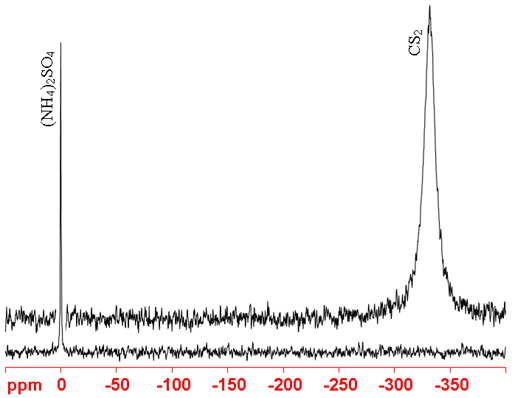(33S) Sulfur NMR
Use our NMR service that provides 33S NMR and many other NMR techniques.
33Sulfur (33S)is a low sensitivity nucleus with a low natural abundance that yields very broad lines over a wide chemical shift range. 33S is a spin 3/2 nucleus and is therefore quadrupolar. As a result, the signal width increases with asymmetry of the environment. Hence, inorganic sulfates and sulfites yield moderately broad signals and small organic sulfites and sulfates are observable. Only the smallest organic sulfides such as CS2 (fig. 1) yield observable signals with a high-resolution spectrometer with DMSO being just too broad (10's of kHz) to be observed. Because of its low sensitivity and broad signals, 33S NMR is little used in high resolution NMR and when it is used it is mostly for sulfates and sulfites. Each type of sulfur signal has its characteristic chemical shifts (fig. 2).
Fig. 1. 33S-NMR spectra of saturated (NH4)2SO4 in D2O and neat CS2 showing increasing linewidth with increasing environmental asymmetry

Fig. 2. Chemical shift ranges for sulfur NMR

Properties of 33S
| Property | Value |
|---|---|
| Spin | 3/2 |
| Natural abundance | 0.760% |
| Chemical shift range | 964 ppm, from -290 to 674 |
| Frequency ratio (Ξ) | 7.676000% |
| Reference compound | sat. (NH4)2SO4 in D2O |
| Linewidth of reference | 10 Hz |
| T1 of reference | 0.015 s |
| Receptivity rel. to 1H at natural abundance | 1.72 × 10-5 |
| Receptivity rel. to 1H when enriched | 2.26 × 10-3 |
| Receptivity rel. to 13C at natural abundance | 0.101 |
| Receptivity rel. to 13C when enriched | 13.3 |
| Linewidth parameter | 61 fm4 |
Safety note
Some of the materials mentioned here are very dangerous. Ask a qualified chemist for advice before handling them. Qualified chemists should check the relevant safety literature before handling or giving advice about unfamiliar substances. NMR solvents are toxic and most are flammable. Specifically, carbon disulfide is a toxic carcinogen: wear protective gloves and work in a hood.